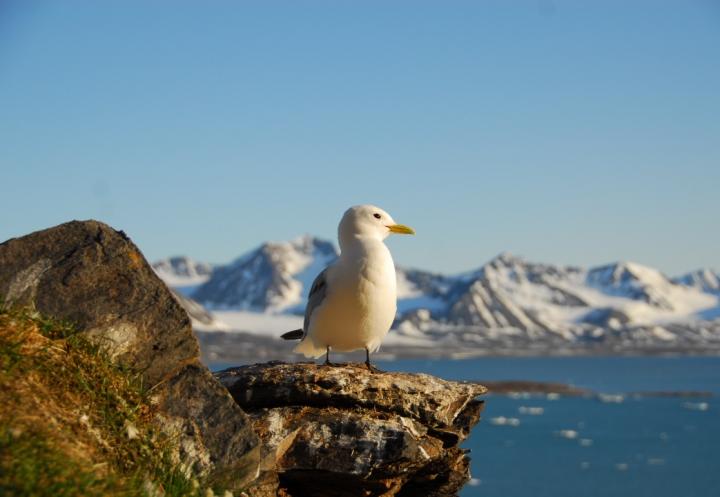When Spring arrives earlier

Credit: Sébastien Descamps
The breeding season of some seabirds in Arctic regions takes place earlier as a result of the temperature rise caused by climate change, according to a science article with Francisco Ramírez, from the Faculty of Biology and the Biodiversity Research Institute (IRBio) of the University of Barcelona -as one of the main authors.
According to the study, published in the journal Global Change Biology, surface-feeding seabirds in the north of the Pacific Ocean are moving their breeding season to an earlier timing than the rest of species -about ten days before for over the last thirty-five years- due the ocean’s temperature rise and ice melting, which are signs of Spring onset in the Arctic.
The first author of this study -which is focused on the analysis of twenty-nine seabird species from thirty-six different locations- is Sébastien Descamps, from the Norwegian Polar Institute in Tromsø (Norway). Other researchers from several institutions and research centers in Norway, Spain, Canada, France and the United States have taken part in the study.
When Spring arrives earlier
The Arctic is one of the most sensitive areas to the global warming effects. Ice melting and the continuous rise of temperatures -higher than the average worldwide- are dramatically altering the structure of the Arctic ecosystems.
“Polar systems are among the most threatened in the world. This is causing substantial changes in environmental conditions which condition the survival of the organisms that live in extreme latitudes. Birds, and specially seabirds, represent one of the most threatened taxonomic groups due the effects of global warming and the human activity impact (fishing, etc.)”, notes Francisco Ramírez, member of the Department of Animal Biology, Ecology and Environmental Sciences.
In Arctic regions, the time period with optimal conditions for the reproduction of seabirds is quite limited. The new study focuses on the analysis of the phenological response of seabirds, and in particular, the link between climate factors and the reproductive cycle of these birds in extreme latitudes.
A limited amount of time to successfully reproduce
“Arctic seabirds only reproduce during a particular time in Spring, when light and temperature conditions as well as food availability are optimal. However, this temporary window with optimal conditions does not last long, and if these animals are not able to adapt, they can fail when trying to reproduce”, comments Francisco Ramírez, the only researcher in Spain to take part in this international study.
Global warming is causing alterations in the breeding season of these seabirds. These try to move their breeding season earlier to adapt -more or less successfully- to this early spring environmental changes. Also, populations of seabirds do not show homogenous patterns when this phenomenon is studied. These seabirds in the north of the Pacific Ocean are the ones to have shown the highest change regarding time in their breeding season, authors note.
Ecology and feeding strategies of each species could also influence in the response of seabirds to this climate challenge. Seabirds that move their breeding the earliest get their food in shallow waters. These are, for instance, the long-tailed jaeger (Stercorarius longicaudus), red-legged kittiwake (Rissa brevirostris), the black-legged kittiwake (Rissa tridactyla), the glaucus gull (Larus hyperboreus), the Arctic tern (Sterna paradisaea), the Leach’s petrel (Oceanodroma leucorhoa), and the northern fulmar (Fulmarus glacialis).
Changes in the breeding season seem less in species that dive to catch preys, such as the Atlantic puffin (Fratercula arctica), the rhinoceros auklet (Cerorhinca monocerata), the tufted puffin (Fratercula cirrhata), the horned puffin (Fratercula corniculata), and the crested auklet (Aethia cristatella).
Surviving the climate crisis
Global warming caused by human activity is affecting organisms in many ways, although many of them are still unknown. However, not all evidence points out to the same direction. Sometimes we find results or evidence that could be contradictory.
“This can only mean there is still a lot to find out about how species respond to the environmental changes that are occurring and the consequences of these responses. Therefore, we have to take these changes, which are taking place in natural ecosystems in general and the arctic ones specifically, very seriously”, notes Francisco Ramírez.
In this context of change, not all living beings can respond in a similar way to the environmental changes caused by global warming. Some species move to higher latitudes or altitudes as the temperature rises, and others change their diet responding to the changes in food availability. There are even some species that have not shown a response, but all these behaviours can influence in the population dynamics of each species and the whole natural ecosystem.
Some of the analysed species in the study -such as red-legged kittiwake (Rissa brevirostris), the Atlantic puffin (Fratercula arctica), and the Leach’s petrel (Oceanodroma leucorhoa) -are listed as vulnerable species in the International Union for Conservation of Nature (IUCN) Red List of Threatened Species. “Regarding the Arctic birds, the changes we observe can have severe consequences in populations, especially if we think about the species with less abilities to adapt the environmental changes due global warming”, warns Ramírez.
Long-term study values in ecology
The study is based on the analysis of record and studies on the control of species in the natural environment carried out over the last thirty-five years. The long-term studies and availability of history data -environmental and biological data- are essential to assess the animals’ response to the environmental changes. “We can only infer the consequences of climate change by having a deep knowledge of these responses, and we have to act consequently if we want to preserve biodiversity”, notes Ramírez.
“However, our research system is strictly focused on short-term studies and penalizes those research projects that need data gathering for long periods of time. Therefore, databases such as the ones we used in this international study are only a few, and thus they are of great scientific value”, concludes the researcher.
###
Media Contact
Rosa Martínez
[email protected]
34-934-035-544
Original Source
https:/




